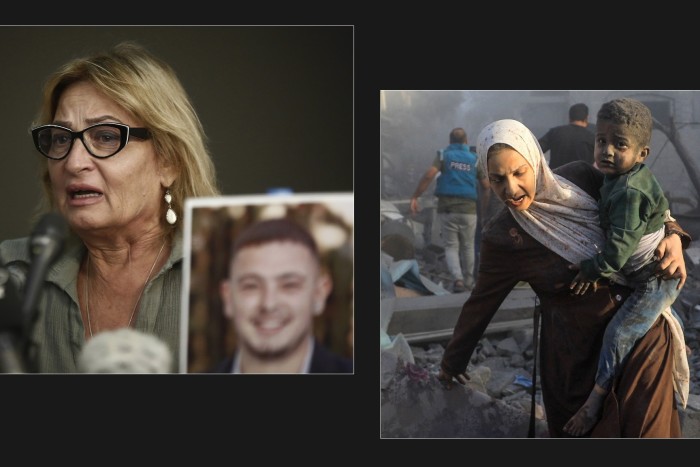Israeli officials have said that a group of freelance Palestinian photographers who transmitted images of the October 7 Hamas raid to international media should be treated as terrorists, claiming that they had prior knowledge of the attack.
The journalists in question sent images of the assault, in which at least 1,400 Israelis were killed, according to Israeli officials, to clients such as the Associated Press and CNN.
Former defence minister Benny Gantz, a member of Israel’s war cabinet, said on Thursday that “journalists found to have known about the massacre, and [who] still chose to stand as idle bystanders while children were slaughtered, are no different than terrorists and should be treated as such”.
Danny Danon, Israel’s representative to the UN, said that Israel had a list of people it would “eliminate” for participating in the raid.
“The ‘photojournalists’ who took part in recording the assault will be added to that list,” he said on X, formerly Twitter.
Israeli officials claimed that the photographers must have had advance knowledge of the raid in order to take the photos, but provided no evidence to support this allegation.
The raid involved thousands of people, lasted several hours and was widely known in Gaza while it was ongoing, drawing massive crowds of onlookers near the border fence.
The photographs, which were seen around the world, included images of Palestinian men, some armed, crossing through breaches in the border fence between the Gaza Strip and Israel during the raid. Others showed injured hostages being dragged into the Gaza Strip.
Gill Hoffman, a former Jerusalem Post reporter and executive director for HonestReporting — the pro-Israel campaign group that circulated the unsupported claims — later told AP he was now satisfied with the answers he had received from various media organisations.
He told AP he had no evidence for the claims, and that his website was not a news organisation. Despite this, the report remained prominently featured on HonestReporting’s website, and was promoted on social media.
“They were legitimate questions to be asked,” Hoffman told AP.
Israel’s government press office, which regulates press passes, said it had demanded clarifications from AP, CNN, The New York Times and Reuters.
The public diplomacy directorate said: “These journalists were accomplices in crimes against humanity; their actions were contrary to professional ethics.”
AP said that it had no knowledge of the October 7 attacks before they happened, and had received photographs from freelancers about an hour after the assault began.
“No AP staff were at the border at the time of the attacks, nor did any AP staffer cross the border at any time. When we accept freelance photos, we take great steps to verify the authenticity of the images and that they show what is purported,” AP said in a statement.
In an 11-day war between Hamas and Israel in 2021, the Israeli military destroyed the multistorey building that housed AP, saying it had evidence that Hamas operatives were using it for military purposes.
One photographer, Hassan Eslaiah, appears to have crossed into Israel and sent images of Hamas fighters in the Kfar Aza kibbutz.
Pro-Israel media watchdogs yesterday shared images of Eslaiah with Hamas leader Yahya Sinwar, including one in which Sinwar was kissing him on the cheek. Eslaiah could not be reached for comment.
CNN said it had cut ties with Eslaiah, who had previously worked for it as a freelance journalist, but was not doing so on October 7. CNN said that it also “had no prior knowledge of the October 7th attacks”. AP also said it was no longer working with Eslaiah.
Reuters also denied that it had any prior knowledge of the attack or that it had embedded journalists with Hamas on October 7. The news agency said it had acquired photographs from two Gaza-based freelance photographers who were at the border on the morning of October 7, but with whom it did not have a prior relationship.
“The photographs published by Reuters were taken two hours after Hamas fired rockets across southern Israel and more than 45 minutes after Israel said gunmen had crossed the border,” it added in a statement.
The New York Times said it was “untrue and outrageous” to suggest anyone at the media group had advanced knowledge of the Hamas attacks, or accompanied any attackers.
Israel-Hamas war: 2-minute briefing

Stay informed with a summary of the latest events plus FT analysis, comment and features
The Committee to Protect Journalists has documented the deaths of at least 39 Palestinians working in the media who have been killed since Israel began a wide aerial bombardment of the Gaza Strip. That was the deadliest month for journalists since the non-profit began collecting data. Another eight were wounded and 13 are missing, the CPJ said.
Several journalists in Gaza have lost multiple members of their families in the bombing, including a celebrated Al Jazeera war correspondent who lost his wife, son, daughter and grandson.
“CPJ emphasises that journalists are civilians doing important work during times of crisis and must not be targeted by warring parties,” said Sherif Mansour, CPJ’s Middle East and north Africa program co-ordinator.
“Those in Gaza, in particular, have paid, and continue to pay, an unprecedented toll and face exponential threats. Many . . . have fled seeking safety when there is no safe haven or exit.”
Stay connected with us on social media platform for instant update click here to join our Twitter, & Facebook
We are now on Telegram. Click here to join our channel (@TechiUpdate) and stay updated with the latest Technology headlines.
For all the latest Business News Click Here
For the latest news and updates, follow us on Google News.
